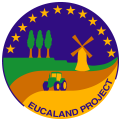Research activities
WP1 Landscape Description: Methods, definitions, cultural character and values
Agricultural landscapes are not just perceived in terms of farming and natural features, but also as a common heritage carrying social and cultural values. The aim is to identify the characteristic components of the EAL, highlighting the cultural, social and psychological benefits for the well-being of the citizens and trends for future developments.
WP2 Landscape History: Major stages in the evolution of EAL
The development of many of the characteristic features of the EAL shows the historical passage of time. The aim is to summarise the history of the EAL and to point out similarities and differences between the countries. Partners therefore collect available data in their countries, outlining the development of their EAL and considering its evolution over time.
WP3 Landscape Classification: Characterisation and classification methods
The aim is to reach consensus for a first classification approach to EAL, to be debated throughout Europe. Such a classification will move on from the various existing European landscape classifications towards a new focus on agricultural landscape types, viewed as the product of history, underlining general aspects and similarities among them. The resulting structure will then be presented at European level.
WP4 Landscape Assessment and Policy: Methods for EAL within the framework of international heritage policies and conventions
Within this WP the EAL is regarded under the international perspective, with the Council of Europe ELC and the UNESCO WHC playing a central role. The EAL is taken into account within the framework of international conventions relevant for EAL protection and awareness.
WP5 Landscape Planning: Recommendations for the consideration of EAL cultural values and heritage
The main aim is to incorporate different European view points and economic, social and ecological trends, when considering cultural values and the heritage of the EAL. From this, recommendations will be drawn up for use as guidelines for politicians, scientists and planners, aimed at making the wider population in Europe more aware of their past culture heritage and hence better able to plan for their future landscape.
WP6 Dissemination of Results
The results of the project are disseminated to the wider public via websites, a travelling exhibition, presentations, publications and other means. Two major outputs will be the final conference and the project book. The Online Collaboration Site for the project partners, hosted by the University of Cambridge, is a valuable tool for internal discussion, communication and dissemination with wiki page, glossary, file storage, calendar and other resources.
Work Package 7 Project Management and Coordination
The project aims to efficiently manage and coordinate this large network of European institutions that have an interdisciplinary and intercultural vision of European Agricultural Landscapes. It also considers the preparation of the necessary documents for the participants, in view of homogenous project progress and methods, which are posted on the Online Collaboration Site dedicated to the project partners. Moreover, WP7 promotes cooperation amongst the partnership, which includes scientists, practitioners, governments and NGOs, at national and international level.
